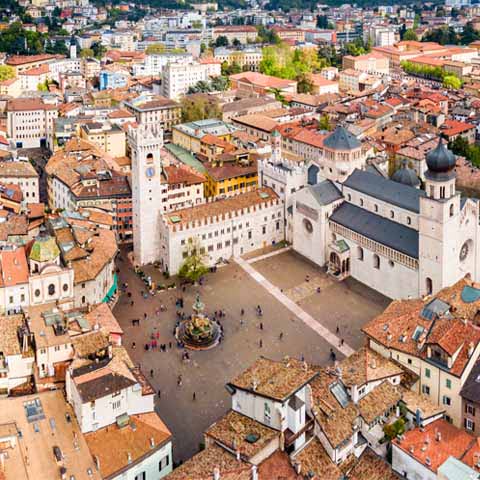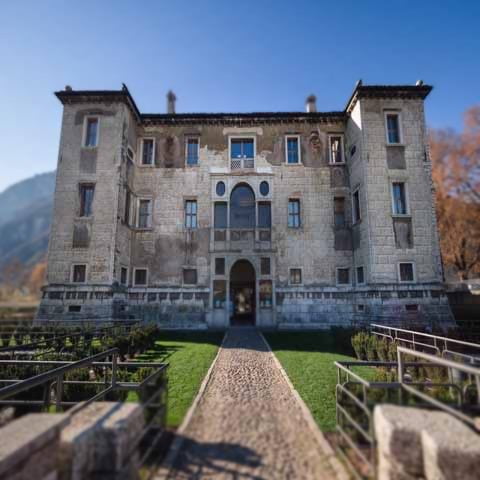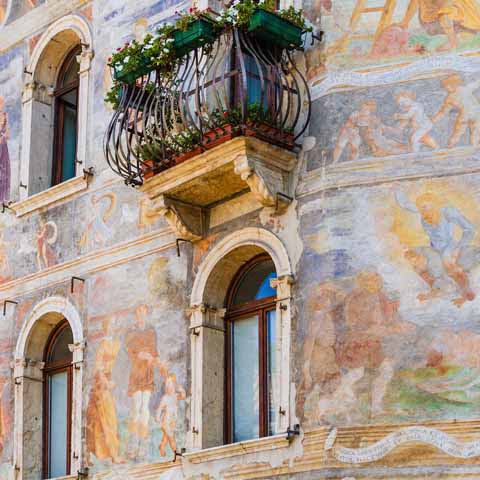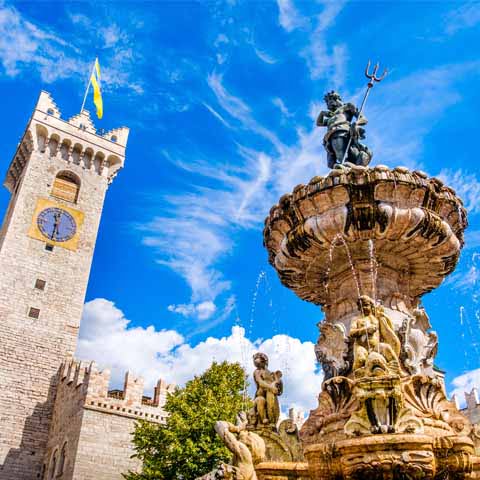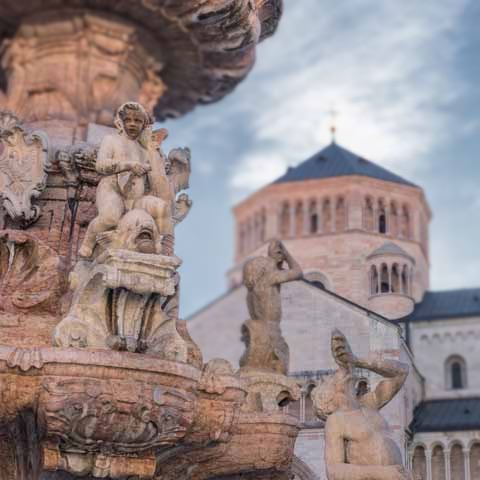Resting upon the shores of the Adige River, historic Trento is an Alpine city tucked away between the peaks of the Dolomites. As the third largest city in the Alpine area, Trento is the capital of the province of Trentino and the region of Trentino-Alto Adige. Trento’s multicultural roots based in Mediterranean and Germanic tradition have shaped the area’s history. During the sixteenth century, the city hosted the influential Council of Trent, which spurred the Counter-Reformation.
The charming historic center of Trento is characterized by medieval and Renaissance architecture as well as rich frescoes and archeological sites. The city is an educational and scientific hub thanks to the University of Trento. The local economy is based on commerce, high-quality agriculture, tourism, and services. Trento is consistently ranked as one of Italy’s top cities in terms of quality of life.
Today, Trento is a desirable travel destination thanks to its Alpine scenery, fascinating museums, and historic churches and palaces.
PREHISTORY OF TRENTO
The name Trento, from the Latin Tridentum, is believed to refer to the three mountains (Bondone, Calisio, and Marzola) or the three hills (Sant’Agata, San Rocco, and Verruca) surrounding the city or — as a third hypothesis — to the three rivers (Adige, Fersina, and Vela) arranged in the form of a trident.
According to some scholars, Trento was a Rhaetian settlement, while others believe it was founded by the Gauls during the fourth century BC.
Certainly Tridentum – Trento was a Roman city from the first century BC, as evidenced by archaeological finds. Tridentum became an important crossroads on the Roman Via Claudia Augusta, the main road that led to the north. Under Augustus, it became an important military base.
HISTORY OF TRENTO
The Lombards chose Trento as the seat of a Duchy, while under the Carolingians Trento became the capital of a Marca (March).
After being invaded by the barbarians and ruled by the Longobards, Trento entered the German sphere of influence in 952.
In 1027, Emperor Conrad II created the Episcopal Principality-Bishop of Trento with both temporal and religious powers. The sovereignty was then divided between the Bishopric of Trent and the County of Tyrol.
In 1363, Trento passed under the rule of the Austrian Habsburg family.
During the fifteenth century, Bishops favored the development of the city. In 1407, the Prince-Bishop George I of Liechtenstein recognized municipal freedom, while Bishop Giovanni Hinderbach (1465-1486) favored the introduction of printing and re-established trade with Venice.
Bishop Bernardo Cles ruled the municipality between 1514 and 1539; he was not only a religious authority but also a politician and patron of art and literature who promoted commerce and the architectural embellishment of the city.
The peasants of the area partly welcomed the Lutheran reform. From 1545 to 1563, Trento hosted the Council that was to start the Counter-Reformation, and the council was officially inaugurated on December 13, 1545. After two interruptions and some vicissitudes, the council ended on December 4, 1563.
The geographical position of Trento made it an ideal bridge between Italy and the German world. Being a city governed by a bishop loyal to the Holy Roman Emperor, it seemed to be the perfect location for both the Papacy and the Holy Roman Empire. The Council led to a deep internal reform of the Catholic Church.
As the Council unfolded, Trento was home to nearly 300 prelates and various other delegates including cardinals, bishops, and theologians who lodged in the city’s monasteries, palaces, and inns. The council met in the Church of Santa Maria Maggiore and the Cathedral of San Vigilio.
In addition to the aforementioned Bishop Cles, another Prince-Bishop, politician, and humanist vital for the city was Cristoforo Madruzzo, who greatly expanded Trento.
In 1558, Cardinal Madruzzo granted a German rabbi named Joseph Ottolengo the privilege of printing Hebrew books.
In the centuries that followed, Trento became a European capital, with courts and delegations from the entire Christian world.
Between the 1700s and 1800s, Trento was under French rule before falling to the Habsburgs.
Towards the middle of the nineteenth century, the completion of the Brenner railway diverted the Adige River to its current course.
Trento was ruled by Prince-Bishops until occupation by French troops during the Napoleonic Era, when it was repeatedly occupied by French troops. During the struggle against France and Bavaria, roughly 4,000 Tridentine volunteers (known as Schützen or Sìzzeri) perished. During this time, resistance leader Andreas Hofer was captured and executed by French soldiers on Napoleon’s direct orders.
Trento ceased to be an ecclesiastical principality and became a city of the Empire, passing under the rule of Napoleon with North and East Tyrol. Trento was part of Napoleon’s Italian Kingdom.
In 1813, the Austrians returned and after Napoleon’s defeat in 1814,Trento was again annexed by the Habsburg Empire.
During the late-nineteenth century, Trento still belonged to the Austrians, and the ethnic Italian majority residing in the city became a symbol of the Italian Irredentist movement that fought for annexation to Italy.
After Italy entered World War I, a deputy in the Austrian parliament named Cesare Battisti fought alongside the Italian Army in an effort to return Trento to Italy. Battisti and second Lieutenant Fabio Filzi were taken prisoners by the Austrian forces and executed in Trento.
After the War, Trento and South Tyrol officially joined Italy in November 1918.
1943 brought a German invasion of Northern Italy with the Trento and Belluno areas of South Tyrol joining the Alpine Foothills Operation Zone, which was annexed to Germany.
Subsequently, Trento was bombed during the “Battle of the Brenner”. Parts of the city were hit by Allied bombings resulting in the destruction of churches, buildings, and bridges. Trento was finally liberated on May 3, 1945.
In 1947, Italy’s Constituent Assembly proclaimed Trentino-Alto Adige to be an autonomous region with its own special charter.
Today, Trento is the capital of the province of Trentino and the region of Trentino-Alto Adige. The city offers a wealth of cultural initiatives and serves as a key destination for cultural tourism.
ARCHAEOLOGY IN TRENTO
The ancient Roman Tridentum lives in the subsoil of the historic city center of Trento. Tridentum occupied approximately 32 acres and the urban geometry was characterized by wide intersecting roads. It was bounded by a wall with towers and moat. It was also protected by the Adige River in the north.
Among the key archaeological sites of Tridentum are the S.A.S.S. – Sas Underground Archaeological Space (located in the basement of the historic Teatro Sociale) and the Paleo Christian Basilica under the Cathedral of San Vigilio.
The S.A.S.S. Archaeological Underground Space of the Sas is a large area that includes public and private spaces and buildings. The exhibition traces nearly half an acre of Roman city history. Below the road system, various ducts related to an articulated sewer network have been brought to light. Some parts of homes with domestic environments, floors decorated with mosaics, rooms with underfloor heating systems, courtyards, a perfectly preserved well, and a glassmaker’s shop are also visible.
Other interesting archaeological sites include Porta Veronensis, located under the Civic Tower in Piazza Duomo, and the archaeological area of Palazzo Lodron.
In addition to these museum sites, other points of the city show traces of ancient history.
The ruins of the Villa of Orpheus, a Roman villa found near Tridentum’s defensive walls, are just one example. Built between the first and second centuries AD, this house takes its name from the myth of Orpheus, which is depicted on a perfectly preserved mosaic. Orpheus, with a lyre in his hands, appears in the center of a circle between pairs of black dolphins and fish.
Outside the walls of Tridentum, on the west side, is a structure built between the first and second centuries AD with two large courtyards and a rich building. Numerous mosaic tiles have been discovered here, some of which even have gold leaf.
In other areas of the city, traces of production plants have been found dating back to between the first and third centuries AD, such as rectangular tubs about 0.27 in. deep, probably used for making fabrics and ropes.
Tridentum, like all Roman cities, had an amphitheater, though, unfortunately, there is nothing left of the arena.
Under Palazzo Crivelli, one of the buildings overlooking Piazza Duomo, part of a large domus built around the second century has been brought to light. The structure was equipped with various rooms including private baths with underfloor heating. The walls were richly decorated. Some walls feature engravings and graffiti.
In a Roman city, the baths played a very important role, not only for the care of the body but also because they were a place of meeting and socialization. At the sixteenth-century Church of Santa Maria Maggiore, archaeological excavations have brought to light the remains of two thermal pools, including furnishings and fragments of statues.
Just above Trento, on a hill called Dos Trento, rest the remains of an early Christian church built between the fifth and tenth centuries. This constitutes further evidence of the presence of a Christian community in Tridentum.
Travel Guides
The Trentino Alto Adige Region of Italy
The Cities of Trentino Alto Adige, Italy
